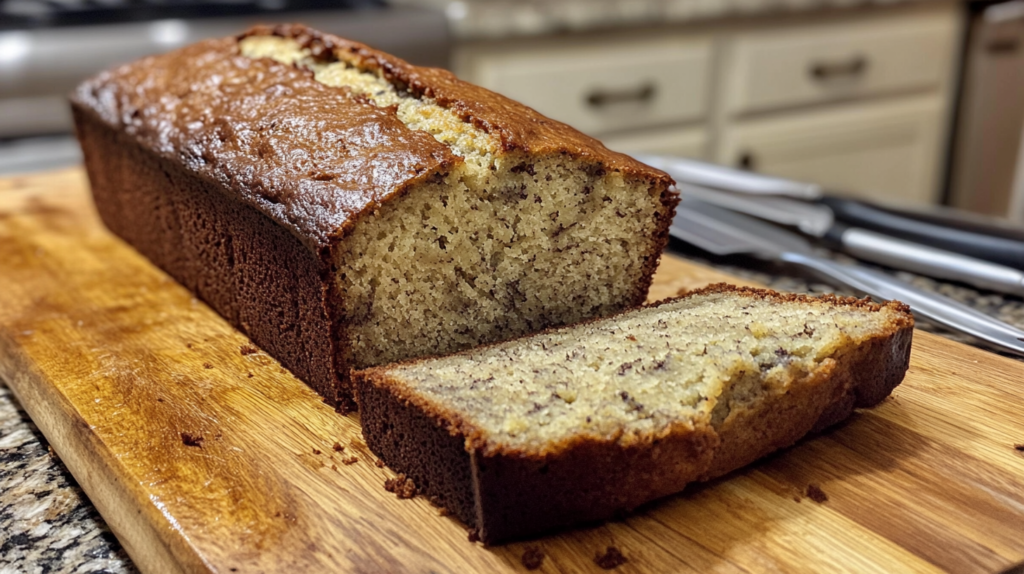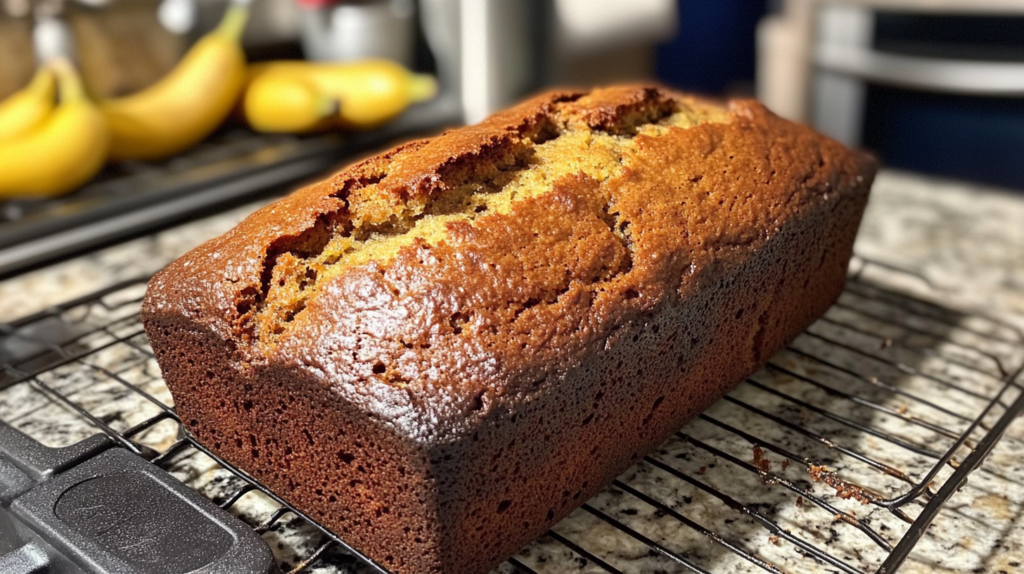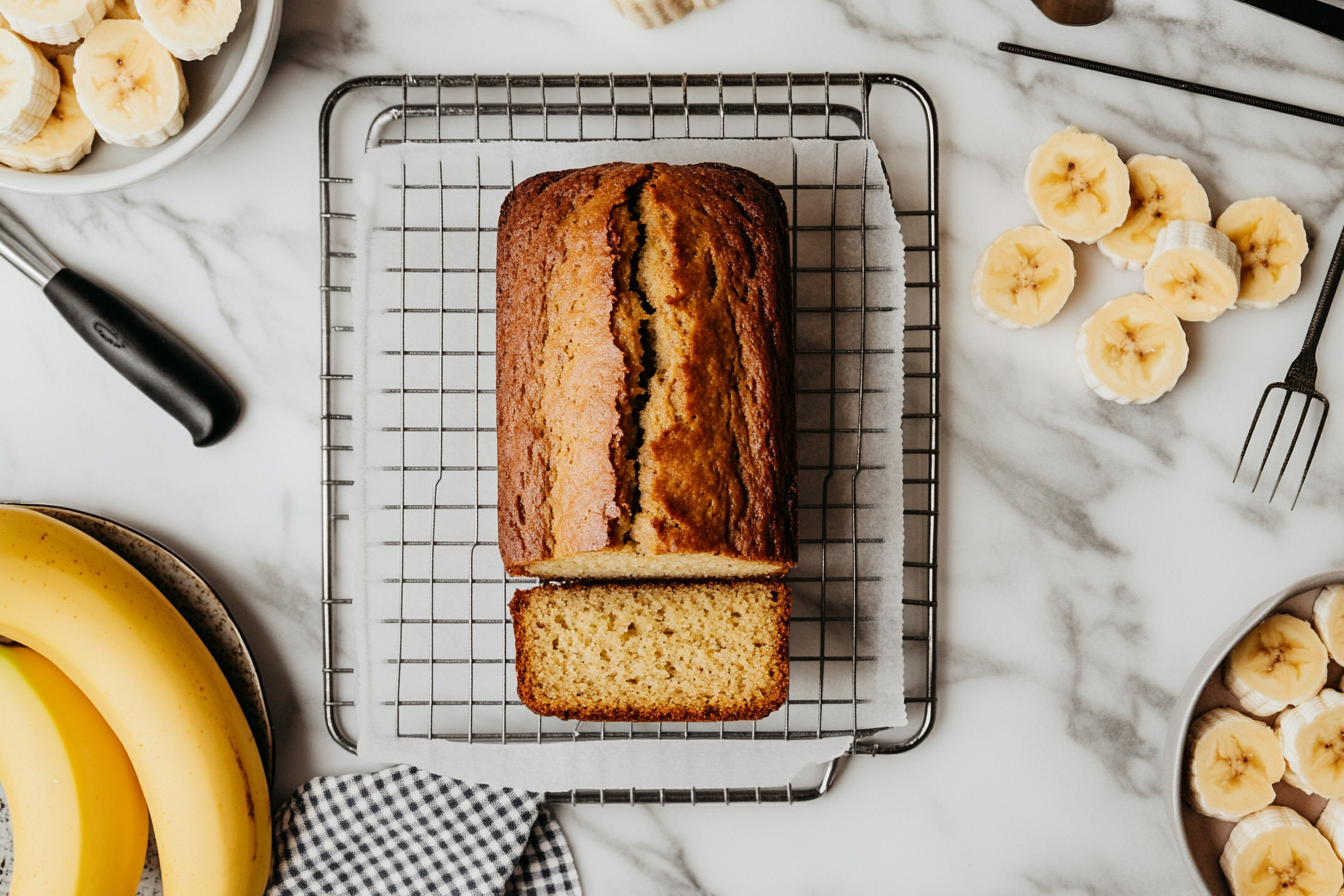Why is banana bread not cooked in the middle? Banana bread has charmed its way into kitchens worldwide, celebrated for its moist texture, sweet aroma, and delightful flavor. However, bakers often encounter an annoying problem: a loaf that’s perfectly golden outside but raw or gooey in the middle. So, why is banana bread not cooked in the middle, and what can you do about it? This guide will delve into the causes and solutions for this baking dilemma, helping you achieve banana bread perfection every time.
Introduction to the Problem
Understanding the Appeal of Banana Bread
Banana bread isn’t just a sweet treat; it’s a nostalgic experience for many, filled with memories of ripe bananas and comforting kitchen aromas. However, this baked delight can be surprisingly tricky. A loaf that looks flawless on the outside can disappoint with an undercooked or sunken middle.
Why Is This a Common Issue?
There are several reasons banana bread is raw in the center. From oven calibration quirks to recipe missteps, small errors can add up to big baking headaches. Uneven heat distribution, incorrect measurements, or even the pan you use might play a role.
Setting the Stage for Solutions
Understanding the problem is the first step. By exploring common mistakes and offering practical fixes, this article aims to ensure you never face the disappointment of an imperfect banana bread loaf again.
Causes of Undercooking
Uneven Heat Distribution
One of the most frequent culprits behind banana bread cooking issues is uneven heat distribution in the oven. Imagine this: your oven might say 350°F, but is it really delivering that temperature consistently throughout? Hot spots or fluctuating heat can leave parts of the bread undercooked while others are perfectly baked.
To address this, start by testing your oven’s temperature with a reliable oven thermometer. Place it in different spots to identify any irregularities. Moreover, if you find hot spots, rotating the pan midway through baking can help.
Inadequate Mixing
Baking relies on precision, and this includes how ingredients are combined. If the batter isn’t mixed thoroughly, flour pockets or uneven wet-to-dry ratios can form, leading to dense, uncooked sections. While it’s essential to mix well, overmixing can also cause problems—such as overly dense bread or uneven rise.
The trick is to fold the ingredients gently but thoroughly. Ensure all the flour is incorporated without beating the batter aggressively. A rubber spatula is your best friend here!
Incorrect Baking Temperature
Another big reason for banana bread being raw in the middle is incorrect baking temperature. Baking at a high temperature may cause the edges and top to brown too quickly while the center remains gooey. Conversely, a too-low temperature can make the loaf take forever to bake, leaving it dry and dense.
Stick to the recipe’s recommended temperature, typically around 325°F to 350°F. If you’re tempted to tweak the temperature, remember that slower and steady heat works better for banana bread.
Pan Size and Material
Your choice of pan can make or break your banana bread. Using a pan that’s too small can cause the batter to overflow, making the loaf unevenly cooked. On the other hand, metal pans conduct heat differently compared to glass or ceramic ones.
Choose the correct pan size, usually 8.5 x 4.5 inches or 9 x 5 inches, and ensure it’s greased or lined with parchment for easy release. If you’re experimenting with pan materials, note that dark metal pans absorb heat faster, which might result in uneven baking.
Small Fixes, Big Results
By understanding these common causes, you’re already halfway to solving the mystery of why banana bread is raw in the center. Simple tweaks—like checking your oven, mixing properly, and using the right pan—can dramatically improve your baking outcomes.

Solutions to Avoid Undercooking
Accurate Oven Calibration
An oven that isn’t calibrated correctly can wreak havoc on your banana bread. If your oven runs hotter or cooler than the temperature you set, the results can vary dramatically. This issue is particularly critical for banana bread cooking evenly.
To ensure accuracy, invest in a reliable oven thermometer. Place it inside the oven, preheat, and compare its reading to the set temperature. If the temperatures don’t match, adjust the settings accordingly. Some ovens have a built-in recalibration feature, or you might need to manually adjust recipes for your oven’s quirks.
Testing with a Toothpick or Thermometer
Relying solely on bake times can be misleading because every oven is unique. Instead, check for doneness by inserting a toothpick or skewer into the center of the bread. If it comes out clean or with a few dry crumbs, your loaf is ready.
For a more precise method, use an instant-read thermometer. The internal temperature of a fully baked banana bread should be around 200°F to 205°F. This step ensures the loaf is cooked through without overbaking.
Adjusting Recipe Ratios
Sometimes the problem lies in the recipe itself. An imbalance of wet and dry ingredients can leave your banana bread too moist to cook through properly. The bananas, eggs, or dairy might overwhelm the flour’s ability to absorb moisture, leading to a soggy center.
To avoid this, follow the recipe’s measurements meticulously. If your bananas are extra large or overly ripe, consider slightly reducing other liquid ingredients. Additionally, ensure the leavening agents, such as baking soda or baking powder, are fresh and measured accurately, as they influence how the bread rises and sets.
Preheating and Placement in the Oven
Skipping preheating is a rookie mistake. A properly preheated oven sets the stage for even cooking from the start. If you place the batter in a cold oven, the center might struggle to catch up as the edges bake.
Furthermore, consider your loaf’s placement in the oven. The middle rack is ideal for banana bread, as it ensures the most even heat exposure. Placing the pan too close to the top or bottom can cause uneven baking, leading to an undercooked center.
Proactive Baking for Perfection
By implementing these solutions, you’ll address the most common pitfalls of baking banana bread. Accurate calibration, thoughtful recipe adjustments, and strategic oven placement can make all the difference in achieving a loaf that’s evenly cooked and irresistibly delicious.
Expert Tips for Perfect Banana Bread
Best Practices for Mixing Batter
Achieving perfectly baked banana bread starts with how you mix the batter. Overmixing can lead to dense, tough bread, while undermixing might leave you with pockets of dry flour or unevenly distributed ingredients. So, how do you strike the right balance?
First, use room-temperature ingredients to ensure everything blends smoothly. Mash the bananas thoroughly to create a consistent texture, then combine wet and dry ingredients gently. Use a spatula and fold the mixture until just combined; a few streaks of flour are okay. Overmixing activates gluten in the flour, making the bread chewy rather than tender.
Using Proper Baking Techniques
The way you handle your batter after mixing can significantly affect the final product. Pour the batter evenly into the pan, ensuring the top is smooth to promote uniform cooking. Avoid overfilling—leave about an inch of space from the rim to prevent spillage and uneven baking.
Additionally, place the pan on the center rack of the oven to allow heat to circulate evenly. If your bread consistently bakes unevenly, consider rotating the pan midway through baking.
Cooling and Storage Tips
Cooling is just as crucial as baking when it comes to achieving the perfect loaf. After removing your banana bread from the oven, allow it to sit in the pan for about 10 minutes. This lets the bread settle and reduces the chance of crumbling when removed.
Transfer the loaf to a wire rack to cool completely. Slicing too soon can cause the bread to collapse or feel gummy. Once cooled, store it in an airtight container to maintain its moist texture. For longer storage, wrap the bread tightly in plastic and refrigerate or freeze it.
Small Tweaks for Big Improvements
Implementing these expert tips can transform your baking results. Simple changes, like folding the batter properly or cooling the loaf correctly, ensure your banana bread emerges as a moist, evenly baked delight every time.
Common Mistakes to Avoid
Rushing the Baking Process
Banana bread may smell irresistible while baking, but rushing to take it out of the oven can lead to disappointment. One of the most common mistakes is underestimating bake time. The outer crust may look golden and done, but the center might still be raw.
Resist the temptation to remove the bread too early! Follow the recipe’s guidelines, but always test for doneness using a toothpick or thermometer. If your loaf isn’t ready, give it more time—trust that patience pays off.
Ignoring Recipe Instructions
Baking is a science, and even small deviations from the recipe can cause problems. Using too much banana, skimping on flour, or mismeasuring liquids can throw off the moisture balance. Additionally, substituting ingredients like whole wheat flour for all-purpose flour without adjusting other elements can lead to uneven baking.
Always measure ingredients precisely and avoid shortcuts. For instance, use a kitchen scale for accuracy when measuring flour, as scooping directly from the bag can compact it, leading to too much being used.
Skipping Pan Preparation
Another frequent error is neglecting to prepare the pan properly. Forgetting to grease or line the pan can cause the bread to stick, which may result in tearing or uneven edges.
To avoid this, grease the pan lightly with butter or cooking spray, and line the bottom with parchment paper for easy removal. These small steps make a big difference in the final presentation of your bread.
Overmixing the Batter
While it’s tempting to mix the batter until smooth, overmixing can activate too much gluten, making the bread dense and tough. This mistake often results in bread that’s unevenly cooked, with a gummy center and overly firm edges.
To prevent this, remember: less is more. Combine the wet and dry ingredients gently, stopping as soon as they’re mixed.
Neglecting to Test Oven Calibration
If your oven runs hot or cool, no amount of careful measuring or mixing will save your banana bread. Ignoring calibration can lead to uneven baking, with bread that’s burnt on the edges and raw in the middle.
Take a moment to check your oven’s accuracy with a thermometer. It’s a simple step that ensures reliable results every time you bake.
Avoiding These Pitfalls
By steering clear of these common mistakes, you can ensure that your banana bread bakes evenly and tastes incredible. Proper preparation, precise measurements, and attention to detail go a long way in avoiding the dreaded undercooked center.
FAQ
Why is my banana bread raw in the middle?
The most common reasons for banana bread being raw in the middle are baking at the wrong temperature, using an incorrect pan size, or not baking the loaf long enough. Uneven heat distribution in your oven might also be a factor. Always test for doneness using a toothpick or thermometer before removing the bread from the oven.
Can I fix undercooked banana bread?
Yes, you can fix undercooked banana bread in many cases! If you discover the issue shortly after taking it out of the oven, place it back in the oven at 325°F for 10–15 minutes. Cover the top with foil to prevent it from over-browning, and bake until the center is fully set.
How can I prevent my banana bread from sinking in the middle?
Sinking banana bread is often caused by overmixing the batter or using too much leavening agent. To prevent this, gently fold the ingredients until just combined, and measure baking soda or powder precisely. Additionally, avoid opening the oven door while the bread is baking, as sudden temperature changes can cause the loaf to collapse.
What is the ideal baking temperature for banana bread?
The recommended temperature for baking banana bread is typically 325°F to 350°F. This range ensures the loaf bakes evenly without overcooking the edges or leaving the center raw. If you’re using a dark or nonstick pan, reduce the temperature by 25°F to avoid over-browning.
Why does my banana bread take longer to cook?
Several factors can cause banana bread to bake longer, including a wetter batter, incorrect oven temperature, or a large, dense loaf. To address this, ensure your oven is preheated and calibrated correctly. Use a pan of the recommended size, and avoid overfilling it with batter.
Should I use a convection oven for banana bread?
Using a convection oven can speed up baking, but it’s not always ideal for banana bread. The circulating air might cause the bread to brown too quickly on the outside, leaving the center undercooked. If you choose to use convection, lower the temperature by 25°F and monitor the loaf closely.
Troubleshooting Made Easy
By understanding these frequently asked questions, you can troubleshoot issues effectively and take proactive steps to bake banana bread that’s perfectly cooked and bursting with flavor.
Conclusion
Recap of Key Insights
Baking banana bread that’s perfectly cooked in the middle doesn’t have to feel like solving a mystery. Understanding the causes of undercooking—such as uneven heat, improper mixing, or incorrect pan choices—empowers you to tackle this issue head-on. By employing practical solutions like calibrating your oven, testing for doneness, and following the recipe precisely, you’re setting yourself up for success.
Incorporating expert tips, like using room-temperature ingredients and cooling the bread properly, can further elevate your baking game. Avoiding common mistakes, such as overmixing the batter or rushing the process, ensures your loaf bakes evenly, with a golden crust and moist interior.
Encouragement for Perfect Baking
Now that you’re armed with the knowledge and techniques to troubleshoot and perfect banana bread, it’s time to hit the kitchen with confidence. Don’t let one or two failed attempts discourage you—baking is all about learning and experimenting. Each loaf brings you closer to mastering the art of this beloved treat.
Remember, even the most seasoned bakers occasionally encounter hiccups. What matters is understanding what went wrong and knowing how to fix it. With these tips, you’ll consistently achieve banana bread that’s as delightful to eat as it is to make.

Enjoy your perfectly baked banana bread and share your creations with friends and family. Happy baking!

